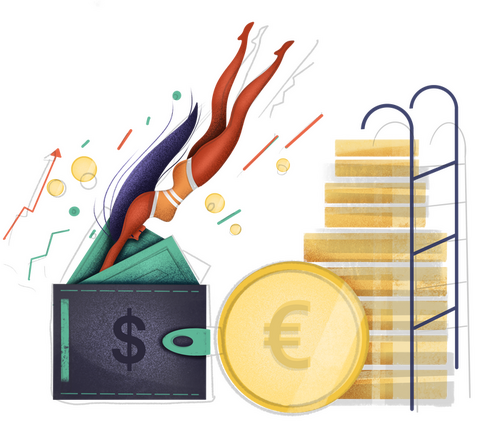Like most Shopify store owners, you probably pay very close attention to things most readily tied to dollar signs — advertising, average order value, conversion optimization, traffic, replenishing inventory, and so on.
Those efforts are important, but there’s another key (oft-forgotten) provision that can have a significant impact on your long-term success.
Hint: it’s how you educate, engage, and assist prospective and existing customers.
If done well, you’re likely to convince lookie-loos to hit <complete purchase> and boost loyalty among your old guard – even if you make a mistake elsewhere in the customer journey. If done exceptionally not well, you risk losing up to 80% of those customers. Eep.
We’re talking about c-u-s-t-o-m-e-r s-e-r-v-i-c-e, y’all!
*collective groan*
We know, we know. Providing great proactive customer service can feel both hard and less important than those obvious moolah-drivers, especially when you think your only choices are to:
- Annoy customers with templated responses and excessive automation
OR
- Sacrifice profit margins to get more support agents on the payroll
WHAT if we told you that there is a way to strike a balance between the personalization your customers demand and the automation you need to make your life…not a living hell? We’re going to. 😏
But first, a primer on why the heck customer service even matters (yes, in very ROI-y terms 💸).
Why is Customer Service Important?
Getting an eCommerce business off the ground is like playing a ridiculously high stakes game of whack-a-mole. You invest countless hours and dollars (and, probably, tears) into product creation, branding, and website design, development, and management -– not to mention order processing, budget analysis, marketing, and anything else specific to your unique business.
Once one task is accomplished (or a fire is put out), another appears.
Can you believe this is the only readily available gif on Giphy–of the actual fire swamp–for “princess bride fire swamp”? Ugh. At least it’s, like, kind of a nod to the “whack-a-mole” thing, right?
Anyway–why and how on earth should you prioritize talking to people in all this chaos?
We’ll get to the “how” in a bit, but first, here are a few good reasons “why”:
Increase Overall Revenue
If you’re looking for just one reason, this is it. Customer service is directly related to revenue. In fact, research by Dimension Data shows that 84% of businesses that continually work to prioritize customer service see an increase in revenue.
Image Source: GrooveHQ
Improve Brand Loyalty and Customer Retention
It is, infamously, expensive as hell to acquire new customers. That being the case, it’s in your best interest to be very good at keeping the ones you’ve got. Customer service is a huge part of that. Get this:
- 95% of customers say that customer service is important for brand loyalty and retention.
- 32% of consumers will stop buying from a brand they love after just one bad experience.
Your beguiling product, savvy Instagramship, and stunning site design may reel ‘em in, but the way you talk to them after they’ve sipped the Kool-Aid is what makes all the difference for retention.
Boost Word of Mouth Marketing & Create Raving Fans
Countless experts, business owners, and marketers swear by word-of-mouth as one of the most effective and low-cost ways to grow a business.
Of course, advertising campaigns, SEO, and PR aren’t going anywhere, but nothing can beat the time-tested power of referrals. Providing exceptional customer service can generate a flock of satisfied customers who will rave about you to their friends (and the internet).
Sounds great, right? It is. But beware! Those referrals don’t just work to your advantage. If customers aren’t happy with your business, they’ll (at best) hold their tongues and just never purchase from you again or (at worst) actively recommend against you.
Meep. How can we encourage the good and limit the bad?
So glad you asked.
What Are The Metrics for Excellent Customer Service?
There are four key components that determine the effectiveness of your customer service efforts:
Personalization
Personalization is essential to building relationships with your customers (new and old), and relationships are crucial to selling more (whether in volume or order value). In fact, 40% of US consumers said they purchased something costlier than they planned to when their experience was personalized.
Image Source: Segment
Simply put, personalization means tailoring your communication to the unique needs and characteristics of each customer (read: addressing the customer by name, or including data related to their specific order(s) or past interactions) instead of just using boring, clearly cookie cutter messaging for everyone.
Personalization makes the customer feel that you or your customer support team "knows" who they’re talking to (and even more important, what’s going on), giving the impression that they’re valuable and not just another ticket languishing in a bloated support base.
Speed
When shopping, who wants to wait for hours to get answers to simple questions like “Does this come in another color?” or “Can you ship to [State/Country]?”
Literally not one person. Speed and accuracy are everything when it comes to customer service. Forrester reports that 53% of US adults will abandon their cart if they don’t get a quick answer to their query.
TL;DR, if customers don’t get what they want in time, they won’t think twice about ditching.
There are many ways to ensure fast customer service. The two most prominent examples are savvily generated automated responses (what’s up, chatbots and macros!) and agents that genuinely know the products (and common company policies around shipping, delivery, and returns) — inside and out.
Convenience
It’s no secret that most humans — especially when there’s money at stake — won’t do anything if they don’t deem it either necessary or easy.
Let’s say a customer contacts your support team and says they can’t figure out how to update the primary phone number on their account. How would you instruct your team to respond?
A. Pleasantly provide the steps for the customer to handle it themselves: go to this page, click here, blah blah blah
B. Respond, "Oh, sorry about that. Let me update it for you. There you go, done! Is there anything else I can do to help you today?
C. A combination of the two
It’s C, obviously.
A isn’t bad but it’s putting the onus entirely on the customer, and especially if they provided the change they wanted made in their original inquiry, could come across as “technically helpful but not really.”
B is wonderfully proactive but impossible to do if the customer hasn’t voluntarily supplied the information, and doesn’t actually empower them to manage things themselves in the future – keeping them annoyingly reliant on customer support.
Superb customer service isn’t just about answering a question; it’s about sensing why it was asked and which response would make the customer’s life easiest — always going the extra mile.
Can’t You Just Automate Everything?
Handling all your customer support cases manually can eat up profits — and quickly. (Wo)manpower is expensive and, especially in the beginning, you can’t predict how many customers you’ll need to support hour-to-hour — let alone day-to-day.
Enter: automation. Use software and macros to handle common inquiries that can be carried out without human intervention and let humans tackle the rest. BUT! Too much automation can have the opposite effect. Your best bet is to pair automation with personalization.
Here’s how.
Best Practices to Balance Automation and Personalization in Customer Service
Customers want relevant resolutions to their unique issues, and they want them now! The right technology, paired with effective personalization, allows you to give the people what they want — without you wanting to tear your hair out.
Use SMS for Personalized Communication
To understand the value of SMS in building meaningful relationships with customers, consider Olipop — an eCommerce brand selling soda with prebiotics, botanicals, and plant fiber.
The company has grown massively in recent years. One of its biggest challenges was to maintain an exceptional level of customer service as their customer base grew from 4 to more than 400,000.
While SMS does suffer a reputation for abuse by sellers and marketers, Olipop had a different vision for the channel — using SMS to build a highly personalized bond with buyers.
They used a combination of Gorgias (a super slick eCommerce helpdesk platform) and Postscript (an SMS marketing solution) to share content in a human voice and encourage two-way interactions.
For example, when a customer responds to an SMS, a support ticket is created automatically in Gorgias. When an agent replies, the message is sent from the same SMS number the customer responded to, making the whole interaction feel like an exchange with a friend rather than a sketchy interaction with some faceless bot out in the digital ether.
As a result of this implementation, Olipop saw an 88% reduction in first response time from support, a 91% decline in resolution time, and more than 1200% growth in revenue. THREE CHEERS for integrating the personalization of SMS with helpdesk automation!
Help Buyers Stay on Top of Order Shipment Status
One of the most frequent customer questions is "Where is my order?” (a.k.a., for real, “WISMO”) — and they want the answer fast. In fact, 83% of buyers expect regular updates about their purchases.
One of the best ways to achieve this is by automating your response. Using a solution like Gorgias, you can set automated answers for WISMO requests. (You’ve also already got regular order and shipping notifications in place, right?)
(You may also want to consider creating a uniquely branded tracking page rife with cross-sell opportunities, which can be accomplished with an app like Malomo.)
Provide Personalized Interactions 24/7
Great customer service is consistent, so templates are always helpful. Personalized templates encourage customer trust and reframe their interaction with you as a human one first.
Templates without personalization can have the opposite effect. Today’s consumer is tech savvy and quick to distinguish between a human message and a robot one. (And, in case we haven’t made it clear so far, they really prefer not to talk to robots about 90% of their inquiries.)
So how do you bridge the gap?
Well, you could make hundreds of templates addressing all possible situations and customers. Since we need that personalization, the messaging will need to relate so specifically to the inquiry that the customer thinks it was written by a real agent, on the spot.
If you’ve been in business for more than a day, you know how much of an LOL this solution is.
You can certainly effectively set up automated responses for inquiries related to returns, shipping status, gift card balances, and other relatively simplistic stuff, but for anything more complicated, your customers will sniff out your computerized response a mile away (and hate it).
Helllloooo, Ada and Gorgias. Using this dynamic duo, you can easily scale personalized customer interactions.
Image Source: Gorgias
This integration automatically registers a support ticket in Gorgias with details that can be used for personalized messaging.
Check out WOW Skin Science — a cosmetics brand that combines natural ingredients with scientific formulations to sell vegan beauty products.
As the company grew, so did the repetitive queries about product ingredients, order tracking, and so on. They wanted a platform that would allow them to streamline their customer service, and Gorgias + Ada were just the ticket.
For example, sometimes shampoo sprung a leak during delivery. (If you’ve seen some of those Ring videos of delivery people drop-kicking packages straight across the lawn onto your porch, it’s no mystery.) With Gorgias + Ada, when a customer having this issue contacts WOW, Ada automatically gathers the information required to initiate a return. All that’s left for the human agent to do is review the details and confirm the refund.
In another example, TruWood utilized the Gorgias and SMSBump integration to offer a personalized experience to buyers needing help, thanks to macros, templates, and SMS messages delivered directly through Gorgias, leading to a 62x return on investment. (Keeping everything under one roof means new hires only have one platform to learn, too – bonus!)
Integrate Inventory, Order, and Shipping Data into Helpdesk Responses
Depending on how you’ve set up your Shopify store and various integrations, the whole customer support tech stack can get pretty complicated — and that can directly impact how much time a support agent takes to resolve customer concerns.
(S)he may have to dig around in multiple systems — your email marketing platform, order processing software, shipping apps, etc. — to corral the customer’s information and answer their query.
Or — WORSE — the agent will be forced to ask the customer for the details they expect your store to have from previous transactions.
Slow response times and dissatisfied shoppers are the result. Alas, you must find a way to unify all the data in one place to make customer support convenient for your support team, as well as the shoppers.
As teased above with TruWood, yes indeed, Gorgias does that. (We really do love them; there’s a reason why they’re the gold standard in customer service platforms!) Support staff can see all of the customer's purchase history in a single location. It seamlessly integrates with Shopify and many other apps you’re currently using to run your business (including social media 🙌 🙌 🙌), meaning your support team can easily respond with personalized data.
Image Source: Gorgias
Offer Self-service Options in Live Chat
The whole point of offering live chat is to solve issues quickly. Why wouldn’t you want to make it even faster with self-service capabilities?
Birddogs — a men’s fashion store — uses Gorgias to accelerate customer support with self-service features. Customers can track an order, initiate a return, or cancel their purchase, without ever chatting with a human agent.
Conclusion
Customer service might feel like the world’s most bothersome gnat (not to mention an ever-moving target), but it’s actually kind of the backbone of your business.
If you want to offer a stellar customer service experience, you need a solid foundation. Automation on its own creates a one-dimensional, impersonal experience. Personalization is fantastic for customers, but can be very cumbersome and costly to you. The goal — if you want to keep your ROI healthy and your customers happy — is to bring personalization, speed, and convenience into perfect sync.
With the right tools and some thoughtful setup you can do just that — and watch your sales tick ever upward.

















